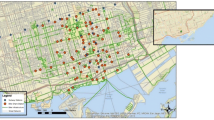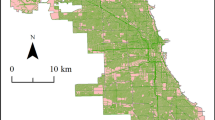Abstract
As bicycling regains popularity around the world, the Beijing Public Bikesharing System, launched in 2012, enables users to access shared bicycles for short trips. After five years of operation, while the system is widely used, it faces the problems of bike unavailability and dock shortage at various stations due to the tidal characteristics of bicycle travel. It is necessary to investigate the influence of different weather conditions and nearby built station environments on bikesharing trips. Using historical trip data from 2016 concerning 543 stations in Beijing, log-linear regression models are developed to estimate the impact of daily weather and time events on bikesharing trips. Moreover, the effects of built environment variables, such as land use and transport infrastructure, are investigated both on workday and non-workday usage at the station level. The results indicate that temperature is not linearly associated with daily usage. Daily usage decreases according to rainfall, snowfall, wind speed and weekends/holidays. Light and heavy pollution have no significant influence on bikesharing demand; however, severe pollution has a negative influence on usage. The effect of transport infrastructure (subway stations, bus stops and bikeway length) is crucial in increasing bikesharing demand. The number of residential and shopping locations is generally associated with usage. Proximity to colleges does not show an obvious usage increase, which is different from the results obtained in other cities. Parks encourage more bikesharing usage on weekends/holidays than on workdays. The findings may help planners or managers to design and modify public bikesharing stations effectively, increasing usage while reducing rebalance costs.


Similar content being viewed by others
References
Bao J, Xu C, Liu P, Wang W (2017) Exploring bikesharing travel patterns and trip purposes using smart card data and online point of interests. Networks & Spatial Economics 17(4):1–23
Beijing Municipal Transportation Operations Coordination Center (2017) Annual report on traffic operation monitoring in Beijing
Bergström A, Magnusson R (2003) Potential of transferring car trips to bicycle during winter. Transportation Research Part A Policy & Practice 37(8):649–666
Buck D, Buehler R (2012) Bike lanes and other determinants of capital bikeshare trips. Proceedings of Transportation Research Board 91st Annual Meeting, Washignton, DC
Buehler R (2012) Virginia tech capital bikeshare study: a closer look at casual users and operations. Department of Urban Affairs and Planning-Alexandria Campus, Virginia Tech, Alexandria: Virginia Tech, 49
Campbell AA, Cherry CR, Ryerson MS, Yang X (2016) Factors influencing the choice of shared bicycles and shared electric bikes in Beijing. Transp Res Part C 67:399–414
Cervero R, Sarmiento OL, Jacoby E, Gomez LF, Neiman A (2009) Influences of built environments on walking and cycling: lessons from Bogotá. International Journal of Sustainable Transportation 3(4):203–226
Chen SY, Lu CC (2016) A Model of Green Acceptance and Intentions to Use Bike-Sharing: Youbike Users in Taiwan. Networks & Spatial Economics 16(4):1103–1124
Cohen A, Shaheen S (2018) Planning for shared mobility. Website. https://www.planning.org/publications/report/9107556/ Accessed 14 Oct 2018
Davis B, Dutzik T, Baxandall P (2012) Transportation and the new generation: Why young people are driving less and what it means for transportation policy[J]. https://www.ospirg.org/sites/pirg/files/reports/Transportation%20%26%20the%20New%20Generation.pdf. Accessed 14 Oct 2018
DeMaio P, Gifford J (2004) Will Smart Bikes Succeed as Public Transportation in the United States? J Public Transp 7(2):1–15
El-Assi W, Mahmoud MS, Habib KN (2017) Effects of built environment and weather on bike sharing demand: a station level analysis of commercial bike sharing in toronto. Transportation 44(3):589–613
Fishman E, Washington S, Haworth N, Watson A (2015) Factors influencing bike share membership: An analysis of Melbourne and Brisbane. Transp Res Part A 71:17–30
Gallop C, Tse C, Zhao J (2012) A Seasonal Autoregressive Model of Vancouver Bicycle Traffic Using Weather Variables. Proceedings of Transportation Research Board 91st Annual Meeting, Washignton, D.C.
Gebhart K, Noland RB (2014) The impact of weather conditions on bikeshare trips in Washington, DC. Transportation 41(6):1205–1225
González F, Melo-Riquelme C, De-Grange L (2016) A combined destination and route choice model for a bicycle sharing system. Transportation 43(3):407–423
Hallock L, Inglis J (2015) The innovative transportation index: the cities where new technologies and tools can reduce your need to own a car. US PIRG Education Fund. https://uspirg.org/reports/usf/innovative-transportation-index Accessed 14 Oct 2018
Hampshire RC, Marla L (2012) An analysis of bike sharing usage: Explaining trip generation and attraction from observed demand. 91st Annual Meeting of the Transportation Research Board, Washington, DC
Jäppinen S, Toivonen T, Salonen M (2013) Modelling the potential effect of shared bicycles on public transport travel times in greater helsinki: an open data approach. Appl Geogr 43(43):13–24
Kim D, Shin H, Im H, Park J (2012) Factors influencing travel behaviors in bikesharing. 91st Annual Meeting of the Transportation Research Board, Washington, DC
Li W, Kamargianni M (2017) A Seasonal Analysis on Factors Affecting Bike-Sharing Choice: With a Focus on Air Pollution's Impact. Proceedings of Transportation Research Board 96st Annual Meeting, Washignton, DC
Lu CC (2016) Robust multi-period fleet allocation models for bike-sharing systems. Networks & Spatial Economics 16(1):1–22
Martin E, Cohen A, Botha JL, Shaheen S (2016) Bikesharing and bicycle safety. Mineta Transportation Institute, San Jose
Martin E, Shaheen S (2014) Evaluating Public Transit Modal Shift Dynamics in Response to Bikesharing: A Tale of Two US Cities. J Transp Geogr 41:315–324
Nair R, Miller-Hooks E, Hampshire RC, Bušić A (2013) Large-scale vehicle sharing systems: analysis of Vélib. International Journal of Sustainable Transportation 7(1):85–106
Noland RB, Smart MJ, Guo Z (2016) Bikeshare Trip Generation in New York City. Transp Res A 94:164–181
Nosal T, Miranda-Moreno LF (2014) The effect of weather on the use of north american bicycle facilities: a multi-city analysis using automatic counts. Transp Res A 66(1):213–225
Osborne J (2005) Notes on the use of data transformations. Pract Assess Res Eval 9(1):42–50
Ricci M (2015) Bike sharing: a review of evidence on impacts and processes of implementation and operation. Research in Transportation Business & Management 15:28–38
Rodrı́Guez DA, Joo J (2004) The relationship between non-motorized mode choice and the local physical environment. Transp Res D 9(2):151–173
Rose G, Ahmed F, Figliozzi M, Jakob C (2011) Quantifying and Comparing Effects of Weather on Bicycle Demand in Melbourne, Australia, and Portland, Oregon. Proceedings of Transportation Research Board 90th Annual Meeting, Washington, D.C
Sakaria N, Stehfest N (2013) Millennials and mobility: understanding the millennial mindset and new opportunities for transit providers. Tcrp Web Document
Shaheen, S., Cohen, A., & Zohdy, I. (2016) Shared mobility: current practices and guiding principles (No. FHWA-HOP-16-022)
Shaheen S, Cohen A, Zohdy I, Kock B (2016) Smartphone applications to influence travel choices: practices and policies (No. FHWA-HOP-16-023)
Shaheen S, Guzman S, Zhang H (2010) Bikesharing in Europe, the Americas, and Asia[J]. Transportation Research Record: J Transp Res Board 2143:159-167
Shaheen S, Martin EW, Cohen AP, Chan ND, Pogodzinski M (2014) Public Bikesharing in North America During a Period of Rapid Expansion: Understanding Business Models, Industry Trends & User Impacts, MTI Report 12-29
Shaheen S, Zhang H, Martin E, Guzman S (2011) China's Hangzhou public bicycle: understanding early adoption and behavioral response to bikesharing. Transp Res Rec 2247(1):33–41
Sun F, Chen P (2017) Impact of Built Environment and Temporal Factors on Public Bike-Sharing. 96st Annual Meeting of the Transportation Research Board, Washington, DC
Thomas T, Jaarsma R, Tutert B (2013) Exploring temporal fluctuations of daily cycling demand on Dutch cycle paths: the influence of weather on cycling. Transportation 40(1):1–22
Winters M, Brauer M, Setton EM, Teschke K (2010) Built environment influences on healthy transportation choices: bicycling versus driving. J Urban Health 87(6):969–993
Yang Y, Li T, Zhang T, Yang W (2017) Understanding the utilization characteristics of bicycle-sharing systems in underdeveloped cities: a case study in Xuchang City, China. Transportation Research Record: Journal of the Transportation Research Board 2634:78–85
Zahran S, Brody SD, Maghelal P, Prelog A, Lacy M (2008) Cycling and walking: explaining the spatial distribution of healthy modes of transportation in the united states. Transportation Research Part D Transport & Environment 13(7):462–470
Zhang H, Shaheen S, Chen X (2014) Bicycle evolution in China: From the 1900s to the present. International Journal of Sustainable Transportation 8(5):317–335
Acknowledgements
This research was sponsored by the National Natural Science Foundation of China (Grant No.: 51578028) and “Beijing Nova” Program by the Beijing Municipal Science and Technology Commission (Grant No.: Z171100001117100).
Author information
Authors and Affiliations
Corresponding author
Additional information
Publisher’s Note
Springer Nature remains neutral with regard to jurisdictional claims in published maps and institutional affiliations.
Rights and permissions
About this article
Cite this article
Lin, P., Weng, J., Liang, Q. et al. Impact of Weather Conditions and Built Environment on Public Bikesharing Trips in Beijing. Netw Spat Econ 20, 1–17 (2020). https://doi.org/10.1007/s11067-019-09465-6
Published:
Issue Date:
DOI: https://doi.org/10.1007/s11067-019-09465-6




